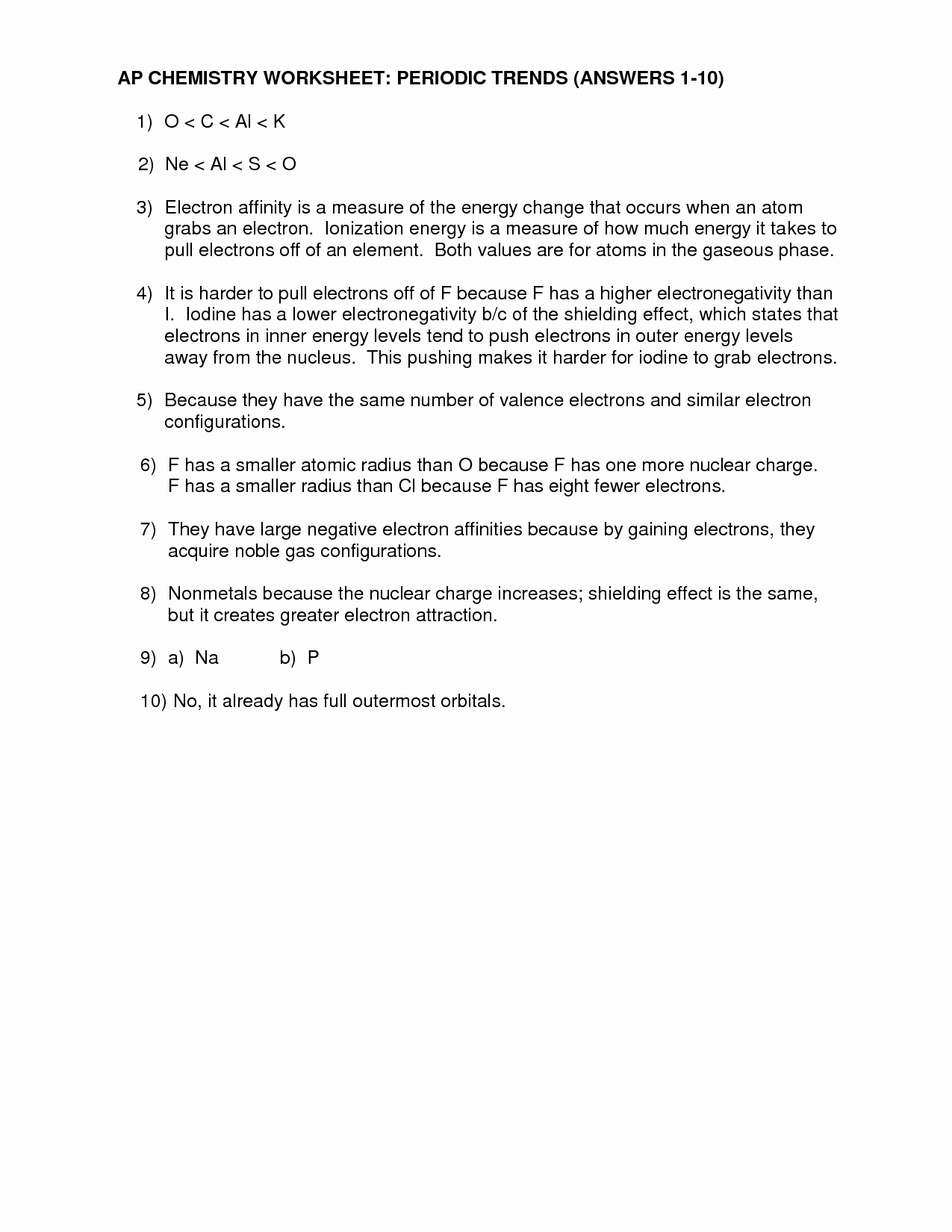Remember those high school chemistry classes filled with confusing diagrams and chemical symbols? I certainly do. The periodic table – this seemingly endless grid of elements – was a constant source of frustration. One particularly challenging aspect was understanding periodic trends, those fascinating patterns in the properties of elements. Luckily, thanks to a well-designed periodic trends worksheet, I finally grasped the concepts behind atomic size, ionization energy, and electronegativity.

Image: zipworksheet.com
Today, I want to share my experience and guide you through the world of periodic trends. While those worksheets might have seemed daunting at first, the answers they provide are key to truly understanding the periodic table. Think of it as a treasure map leading you to the secrets of how elements behave and interact.
Unveiling the Patterns: The Periodic Trends Explained
Understanding the Basics
The periodic table isn’t just a random arrangement of elements. It’s a carefully designed system that reflects the fundamental properties of atoms. These properties change predictably as we move across periods (horizontal rows) and down groups (vertical columns) in the table. These changes are known as periodic trends.
At the heart of these trends lies the atomic structure. As we move across a period, the number of protons and electrons increases, leading to stronger attractions between the nucleus and electrons. This results in smaller atomic radii and a greater tendency to gain electrons. Conversely, moving down a group, the number of electron shells increases, resulting in larger atomic radii and a weaker hold on outer electrons.
Key Trends:
Let’s dive into the most common periodic trends:
- Atomic Radius: As you move down a group, atomic radius increases. Conversely, as you move across a period, atomic radius decreases. This trend is explained by the increasing number of electron shells and stronger nuclear attraction, respectively.
- Ionization Energy: This is the energy required to remove an electron from an atom. Ionization energy increases as you move across a period and decreases as you move down a group. The stronger nuclear attraction in smaller atoms and the greater distance between the nucleus and outermost electrons in larger atoms explain these trends.
- Electronegativity: This refers to an atom’s ability to attract electrons in a chemical bond. Electronegativity increases as you move across a period and decreases as you move down a group. This aligns with the increasing nuclear charge and decreasing atomic size across a period, making atoms more likely to attract electrons.
- Electron Affinity: This is the change in energy that occurs when an electron is added to a neutral atom to form a negative ion. While electron affinity can be complex, it generally increases as you move across a period and decreases as you move down a group, following similar trends driven by nuclear charge and atomic size.

Image: chessmuseum.org
Unlocking the Power of Periodic Trends Worksheets
Think of periodic trends worksheets as your personal guide to navigating this fascinating world of atomic properties. By completing these worksheets, you’ll not only understand the trends but also start to “see” the patterns in the periodic table. This is vital for building a strong foundation in chemistry and understanding how elements interact.
Here’s how these worksheets can help you:
- Visual Representation: Worksheets provide a clear and concise visual representation of the trends, making it easier to understand the relationships between elements and their properties.
- Practice and Reinforcement: The practice questions on these worksheets help you solidify your understanding of the trends through real-world applications.
- Identifying Exceptions: Understanding the trends is crucial, but it is equally important to know the exceptions. Worksheets often highlight these exceptions, forcing you to explore the nuances of periodic trends.
Tips for Mastering Periodic Trends:
- Visualize the Trends: Use diagrams, flashcards, or even physical models to visualize the trends and remember the patterns.
- Practice with Plenty of Problems: The more problems you tackle, the better you’ll understand the underlying principles.
- Develop a Periodic Table Mnemonic: Creating a mnemonic device can help you remember the trends for different properties, especially when dealing with exceptions.
- Study the Periodic Table Regularly Familiarity with the periodic table is essential for understanding periodic trends. Make a habit of reviewing it regularly.
FAQ: Periodic Trends Demystified
Q: Why are periodic trends important in chemistry?
A: Understanding periodic trends allows us to predict the chemical and physical properties of elements. This knowledge is essential for understanding how elements react, form compounds, and behave in different environments.
Q: How can I use periodic trends to predict the reactivity of an element?
A: Elements with low ionization energies readily lose electrons, making them highly reactive. Similarly, elements with high electronegativity are more likely to gain electrons, also contributing to their reactivity.
Q: What are some applications of periodic trends in real life?
A: Periodic trends play a significant role in various fields, including material science, drug development, and energy production. For example, understanding electronegativity helps us design efficient catalysts for chemical reactions, while knowledge of ionization energy allows for the development of new energy storage technologies.
Periodic Trends Worksheet Answers
In Conclusion: Unlocking the Power of the Periodic Trends
So, there you have it: a comprehensive overview of periodic trends and the role of worksheets in mastering them. By exploring these trends, you unlock the secrets hidden within the periodic table. Remember: understanding periodic trends is not just about memorizing facts; it’s about comprehending the fundamental principles that govern the behavior of matter.
Are you ready to dive deeper into the world of periodic trends? Let me know what other aspects of this topic you’d like to explore in the comments below!






